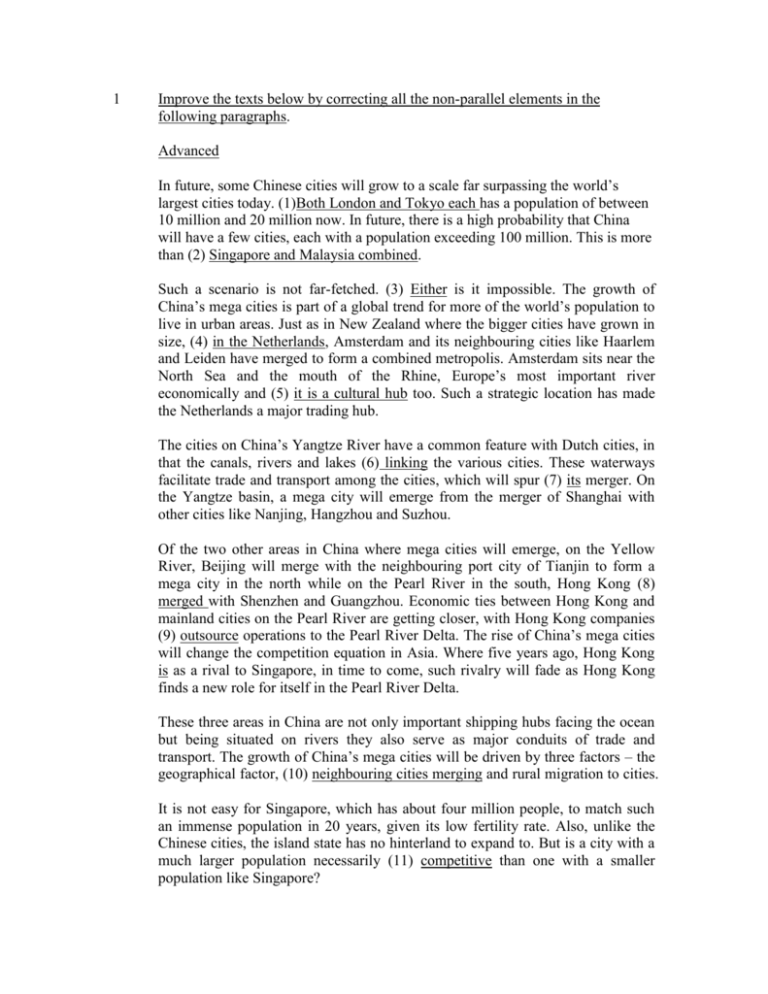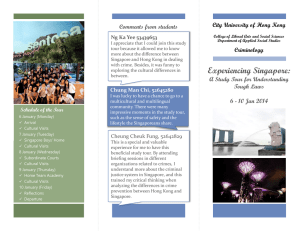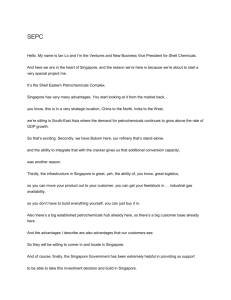Correct all the non-parallel elements in the following paragraph
advertisement

1 Improve the texts below by correcting all the non-parallel elements in the following paragraphs. Advanced In future, some Chinese cities will grow to a scale far surpassing the world’s largest cities today. (1)Both London and Tokyo each has a population of between 10 million and 20 million now. In future, there is a high probability that China will have a few cities, each with a population exceeding 100 million. This is more than (2) Singapore and Malaysia combined. Such a scenario is not far-fetched. (3) Either is it impossible. The growth of China’s mega cities is part of a global trend for more of the world’s population to live in urban areas. Just as in New Zealand where the bigger cities have grown in size, (4) in the Netherlands, Amsterdam and its neighbouring cities like Haarlem and Leiden have merged to form a combined metropolis. Amsterdam sits near the North Sea and the mouth of the Rhine, Europe’s most important river economically and (5) it is a cultural hub too. Such a strategic location has made the Netherlands a major trading hub. The cities on China’s Yangtze River have a common feature with Dutch cities, in that the canals, rivers and lakes (6) linking the various cities. These waterways facilitate trade and transport among the cities, which will spur (7) its merger. On the Yangtze basin, a mega city will emerge from the merger of Shanghai with other cities like Nanjing, Hangzhou and Suzhou. Of the two other areas in China where mega cities will emerge, on the Yellow River, Beijing will merge with the neighbouring port city of Tianjin to form a mega city in the north while on the Pearl River in the south, Hong Kong (8) merged with Shenzhen and Guangzhou. Economic ties between Hong Kong and mainland cities on the Pearl River are getting closer, with Hong Kong companies (9) outsource operations to the Pearl River Delta. The rise of China’s mega cities will change the competition equation in Asia. Where five years ago, Hong Kong is as a rival to Singapore, in time to come, such rivalry will fade as Hong Kong finds a new role for itself in the Pearl River Delta. These three areas in China are not only important shipping hubs facing the ocean but being situated on rivers they also serve as major conduits of trade and transport. The growth of China’s mega cities will be driven by three factors – the geographical factor, (10) neighbouring cities merging and rural migration to cities. It is not easy for Singapore, which has about four million people, to match such an immense population in 20 years, given its low fertility rate. Also, unlike the Chinese cities, the island state has no hinterland to expand to. But is a city with a much larger population necessarily (11) competitive than one with a smaller population like Singapore? For the longest time, China’s population (12) dwarfed Singapore, but its quality of life, historically, was so low that many Chinese migrated to Singapore. Some economists say the quality of China’s economic growth is poor, pointing out the hundreds of billions of dollars of bad loans China’s banks need to write off and (13) its lack of financial transparency. Shanghai, Beijing and Guangzhou are catching up with Singapore in their quality of life and infrastructure. With China’s entry into the World Trade Organization (WTO), more multinationals will place their Asian headquarters in Shanghai, Guangzhou or Beijing. Furthermore, China’s growth is faster than Singapore’s or its neighbours’. Short of either a financial crisis (14)and political calamity, Chinese mega cities will pose far stiffer competition to Singapore than her neighbours (15) are. To cope with the rise of the Chinese mega cities, Singapore should increase links with its neighbours, namely Johor and the Indonesian Riau Islands or in a few decades, Singapore might prosper, but Chinese mega cities (16) must overtake it. Key: In future, some Chinese cities will grow to a scale far surpassing the world’s largest cities today. (1)London and Tokyo each has a population of between 10 million and 20 million now. In future, there is a high probability that China will have a few cities, each with a population exceeding 100 million. This is more than (2) that of Singapore and Malaysia combined. Such a scenario is not far-fetched. (3) Nor is it impossible. The growth of China’s mega cities is part of a global trend for more of the world’s population to live in urban areas. Just as in New Zealand where the bigger cities have grown in size, (4) in the Netherlands too, Amsterdam and its neighbouring cities like Haarlem and Leiden have merged to form a combined metropolis. Amsterdam sits near the North Sea and the mouth of the Rhine, Europe’s most important river economically and (5) culturally too. Such a strategic location has made the Netherlands a major trading hub. The cities on China’s Yangtze River have a common feature with Dutch cities, in that the canals, rivers and lakes (6) link the various cities. These waterways facilitate trade and transport among the cities, which will spur (7) their merger. On the Yangtze basin, a mega city will emerge from the merger of Shanghai with other cities like Nanjing, Hangzhou and Suzhou. Of the two other areas in China where mega cities will emerge, on the Yellow River, Beijing will merge with the neighbouring port city of Tianjin to form a mega city in the north while on the Pearl River in the south, Hong Kong (8) will merge with Shenzhen and Guangzhou. Economic ties between Hong Kong and mainland cities on the Pearl River are getting closer, with Hong Kong companies (9) outsourcing operations to the Pearl River Delta. The rise of China’s mega cities will change the competition equation in Asia. Where five years ago, Hong Kong is as a rival to Singapore, in time to come, such rivalry will fade as Hong Kong finds a new role for itself in the Pearl River Delta. These three areas in China are not only important shipping hubs facing the ocean but being situated on rivers they also serve as major conduits of trade and transport. The growth of China’s mega cities will be driven by three factors – the geographical factor, (10) the merger of neighbouring cities and rural migration to cities. It is not easy for Singapore, which has about four million people, to match such an immense population in 20 years, given its low fertility rate. Also, unlike the Chinese cities, the island state has no hinterland to expand to. But is a city with a much larger population necessarily (11) more competitive than one with a smaller population like Singapore? For the longest time, China’s population (12) dwarfed that of Singapore, but its quality of life, historically, was so low that many Chinese migrated to Singapore. Some economists say the quality of China’s economic growth is poor, pointing out the hundreds of billions of dollars of bad loans China’s banks need to write off and (13) their lack of financial transparency. Shanghai, Beijing and Guangzhou are catching up with Singapore in their quality of life and infrastructure. With China’s entry into the World Trade Organization (WTO), more multinationals will place their Asian headquarters in Shanghai, Guangzhou or Beijing. Furthermore, China’s growth is faster than Singapore’s or its neighbours’. Short of either a financial crisis (14) or political calamity, Chinese mega cities will pose far stiffer competition to Singapore than her neighbours (15) will. To cope with the rise of the Chinese mega cities, Singapore should increase links with its neighbours, namely Johor and the Indonesian Riau Islands or in a few decades, Singapore might prosper, but Chinese mega cities (16) might overtake it.








